Cancer mortality in former East and West Germany: a story of unification?
- PMID: 28148231
- PMCID: PMC5288858
- DOI: 10.1186/s12885-017-3086-y
Cancer mortality in former East and West Germany: a story of unification?
Abstract
Background: Health and social conditions vary between West and East Germany.
Methods: We analyzed annual mortality data of all recorded deaths caused by lung, colorectal, breast and prostate cancer in Germany as they are published by the Federal Bureau of Statistics (FBS) encompassing the period 1980-2014 for former West Germany (WG) and 1990-2014 for former East Germany (EG). To compare East and West Germany we computed the ratio of the mortality rates in both parts (mortality rate ratio, MRR, <1 indicates a lower mortality in EG). Forecasting methods of time series analyses were applied (model selection based on the Box/Jenkins approach) to predict 5-year trends until 2019.
Results: Lung cancer: In women mortality rose in both regions (WG: +2.8%, 1991-2014, EG: +2.2%, 1990-2014). In men mortality in WG declined between -2.1% and -1.2%, and by -2.7% (1993-2009) in EG which was followed by a plateau. Colorectal cancer: A decline was found in both WG (-3.1%, 1993-2014) and EG women (-3.8%, 1993-2008 and -2.0%, 2008-2014). A decline in EG men since 1992 (-0.9%, 1992-1997 and -2.3%, 1997-2014) mirrors the development in WG (-2.6%, 1995-2014). Breast cancer: Constant mortality decline in WG after 1996. In EG a decline (-2.4%, 1992-2007) was followed by a plateau with an MRR <1 (1990-2014). Prostate cancer: In WG a decline (-3.4%) came to a hold after 2007, while there was a constant decline of 1.5% in EG. The forecast indicated that mortality of colorectal/lung cancer in men and breast cancer reaches a plateau in future years.
Conclusion: Courses of mortality were similar between East and West, while existing differences are likely to remain in the near future.
Figures
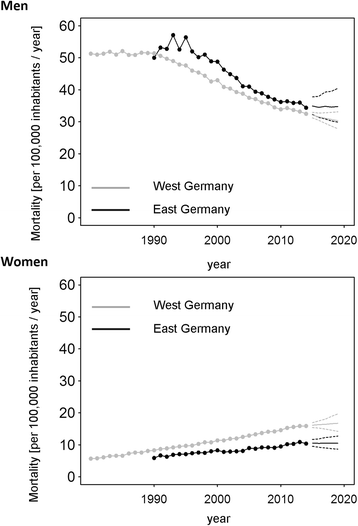
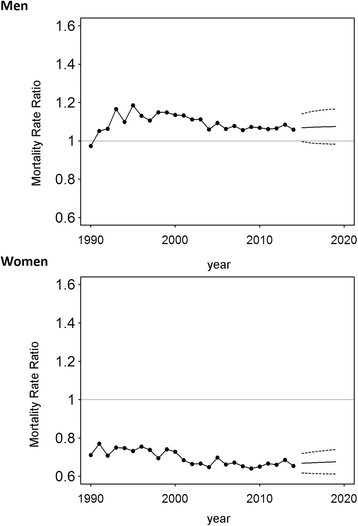
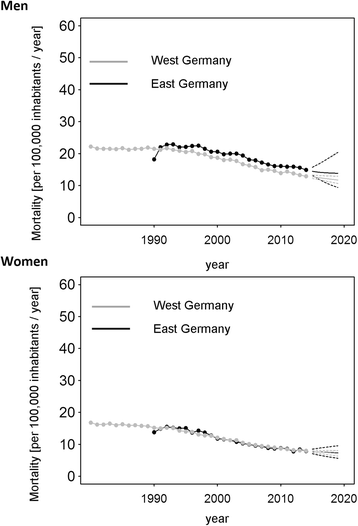
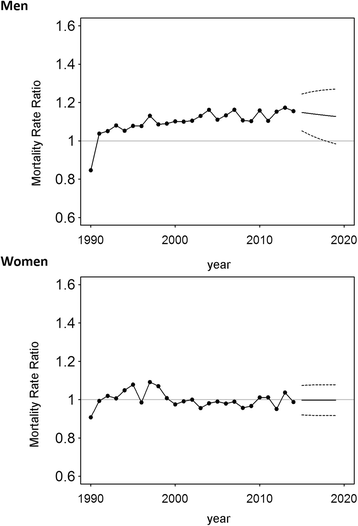
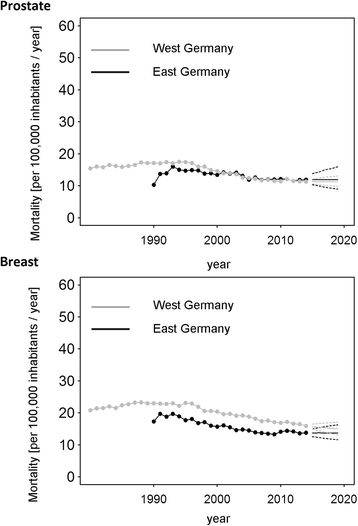

Similar articles
-
A comparison of the treatment of severe injuries between the former East and West German States.Dtsch Arztebl Int. 2013 Mar;110(12):203-10. doi: 10.3238/arztebl.2013.0203. Epub 2013 Mar 22. Dtsch Arztebl Int. 2013. PMID: 23589743 Free PMC article.
-
Reversing East-West mortality difference among German women, and the role of smoking.Int J Epidemiol. 2013 Apr;42(2):549-58. doi: 10.1093/ije/dyt008. Epub 2013 Mar 4. Int J Epidemiol. 2013. PMID: 23460605
-
Mortality of Testicular Cancer in East and West Germany 20 Years after Reunification: A Gap Not Closed Yet.Urol Int. 2015;95(2):160-6. doi: 10.1159/000381883. Epub 2015 May 7. Urol Int. 2015. PMID: 25966659
-
'Lifestyle' and cancer rates in former East and West Germany: the possible contribution of diagnostic radiation exposures.Radiat Prot Dosimetry. 2011 Sep;147(1-2):310-3. doi: 10.1093/rpd/ncr348. Epub 2011 Aug 10. Radiat Prot Dosimetry. 2011. PMID: 21835840
-
[Epidemiology of colorectal cancer].Radiologe. 2003 Feb;43(2):98-104. doi: 10.1007/s00117-003-0868-9. Radiologe. 2003. PMID: 12624666 Review. German.
Cited by
-
The Burden, Future Trends, And Economic Impact Of Lung Cancer In Saudi Arabia.Clinicoecon Outcomes Res. 2019 Nov 19;11:703-712. doi: 10.2147/CEOR.S224444. eCollection 2019. Clinicoecon Outcomes Res. 2019. PMID: 31819562 Free PMC article.
-
Development and validation of the Individual Potentials Questionnaire (IP-Q).Sci Rep. 2025 Mar 28;15(1):10708. doi: 10.1038/s41598-025-90868-6. Sci Rep. 2025. PMID: 40155407 Free PMC article.
-
Predictors of the regional variation of prostatectomy or radiotherapy: evidence from German cancer registries.J Cancer Res Clin Oncol. 2020 May;146(5):1197-1204. doi: 10.1007/s00432-020-03140-x. Epub 2020 Mar 4. J Cancer Res Clin Oncol. 2020. PMID: 32130481 Free PMC article.
-
Early motor function after local treatment of brain metastases in the motor cortex region with stereotactic radiotherapy/radiosurgery or microsurgical resection: a retrospective study of two consecutive cohorts.Radiat Oncol. 2017 Nov 13;12(1):177. doi: 10.1186/s13014-017-0917-6. Radiat Oncol. 2017. PMID: 29132382 Free PMC article.
-
Avoidable Cancer Mortality in Germany Since Reunification: Regional Variation and Sex Differences.Front Public Health. 2019 Jul 10;7:187. doi: 10.3389/fpubh.2019.00187. eCollection 2019. Front Public Health. 2019. PMID: 31355174 Free PMC article.
References
-
- Baili P, Di Salvo F, Marcos-Gragera R, Siesling S, Mallone S, Santaquilani M, Micheli A, Lillini R, Francisci S, Group E-W: Age and case mix-standardised survival for all cancer patients in Europe 1999–2007: Results of EUROCARE-5, a population-based study. Eur J Cancer. 2015;51(15):2120–2129. - PubMed
-
- Lillini R, Vercelli M, Quaglia A, Micheli A, Capocaccia R. Use of socio-economic factors and healthcare resources to estimate cancer survival in European countries with partial national cancer registration. Tumori. 2011;97(3):265–274. - PubMed
Publication types
MeSH terms
LinkOut - more resources
Full Text Sources
Other Literature Sources
Medical

